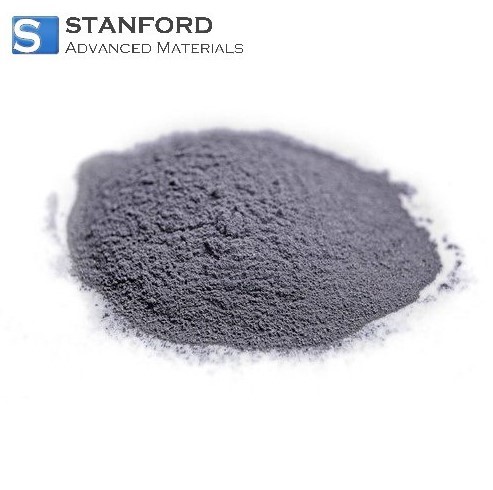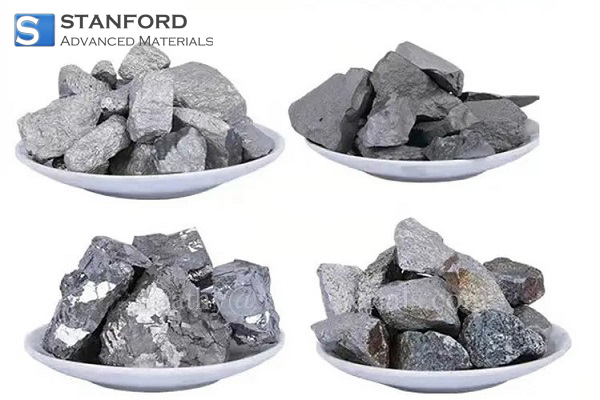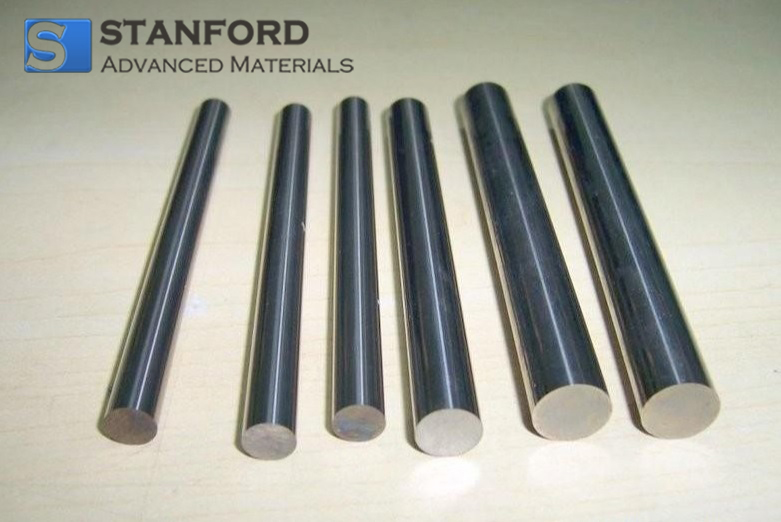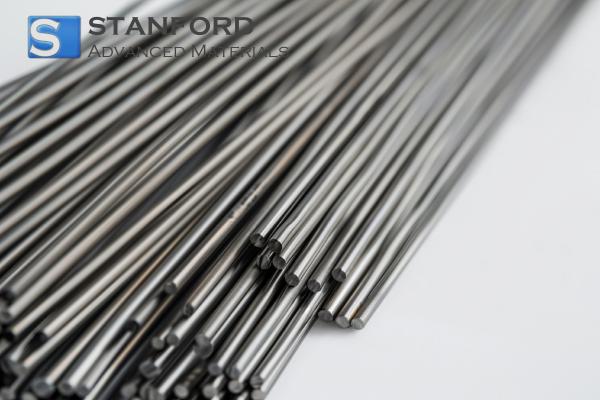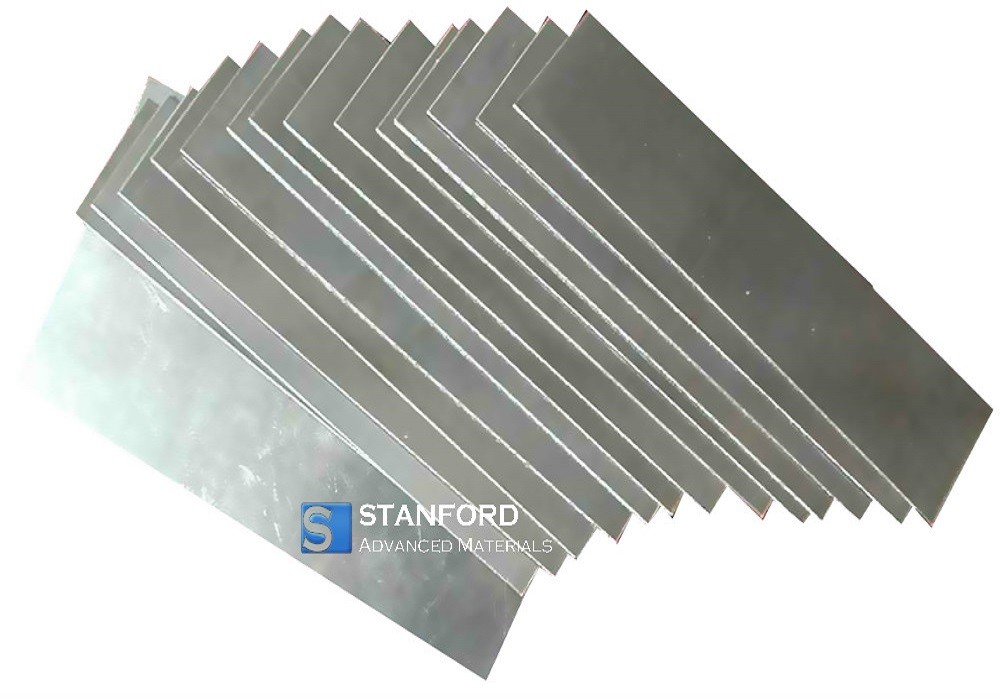SECTION 1. IDENTIFICATION
Product Name: Aluminum Nickel Alloy Powder
CAS #: 12635-29-9
Relevant identified uses of the substance: Scientific research and development
Supplier details:
Stanford Advanced Materials
E-mail: sales@samaterials.com
Tel: (949) 407-8904
Address: 23661 Birtcher Dr., Lake Forest, CA 92630 U.S.A.
SECTION 2. HAZARDS IDENTIFICATION
This chemical is considered hazardous by the 2012 OSHA Hazard Communication Standard (29 CFR
1910.1200).
Classification
Skin sensitization Category 1
Carcinogenicity Category 2
Flammable solid Category 1
Label elements
Signal word Warning
Hazard statements May cause an allergic skin reaction
Suspected of causing cancer
Flammable solid
Precautionary Statements - Prevention Obtain special instructions before use
Do not handle until all safety precautions have been read and
understood
Use personal protective equipment as required
Avoid breathing dust/fume/gas/mist/vapors/spray
Contaminated work clothing should not be allowed out of theworkplace
Wear protective gloves
Keep away from heat/sparks/open flames/hot surfaces. — No
smoking
Precautionary Statements - Response
Ground/bond container and receiving equipment
IF exposed or concerned: Get medical advice/attention
IF ON SKIN: Wash with plenty of soap and water
If skin irritation or rash occurs: Get medical advice/attention
Wash contaminated clothing before reuse
In case of fire: Use CO2, dry chemical, or foam for extinction
Precautionary Statements - Storage Store locked up
Precautionary Statements - Disposal Dispose of contents/container to an approved waste disposal
plant
Hazards not otherwise classified (HNOC)
Hazards not otherwise classified (HNOC) N/A
Other Information
NFPA
Health hazards 2
Flammability 0
Stability 3
Physical and chemical
properties
-
HMIS
Health hazards 2
Flammability 0
Physical hazards 3
Personal protection -
SECTION 3. COMPOSITION/INFORMATION ON INGREDIENTS
CAS No 12635-27-7
Molecular Weight 85.67
Formula AlNi
Chemical Name CAS No Weight % Oral LD50 Dermal LD50 Inhalation LC50
Aluminum-nickel catalyst 12635-27-7 >98 - - -
SECTION 4. FIRST AID MEASURES
First Aid Measures
General advice Immediate medical attention is required. In case of accident or unwellness, seek
medical
advice immediately (show directions for use or safety data sheet if possible).
Eye contact Immediately flush with plenty of water. After initial flushing, remove any contact lenses
and
continue flushing for at least 15 minutes. Keep eye wide open while rinsing. Call a physician
immediately.
Skin Contact Wash off immediately with plenty of water. Wash off immediately with soap and plenty of
water. Consult a physician if necessary.
Inhalation Remove to fresh air Avoid direct contact with skin. Use barrier to give mouth-to-mouthresuscitation Immediate medical attention is required If not breathing, give artificial
respiration Oxygen or artificial respiration if needed Call a physician
Ingestion Do NOT induce vomiting. Drink plenty of water. Never give anything by mouth to an
unconscious person. Call a physician or poison control center immediately.
Self-protection of the first aider Remove all sources of ignition.
Most important symptoms and effects, both acute and delayed
Symptoms No data available.
Indication of any immediate medical attention and special treatment needed
Note to physicians May cause sensitization of susceptible persons.
SECTION 5. FIREFIGHTING MEASURES
Suitable Extinguishing Media
Suitable Extinguishing Media Use extinguishing measures that are appropriate to local circumstances
and the
surrounding environment.
Unsuitable Extinguishing Media None.
Specific hazards arising from the chemical
Specific hazards arising from the
chemical
In the event of fire and/or explosion do not breathe fumes. May cause sensitization by
inhalation and skin contact. Thermal decomposition can lead to release of irritating and
toxic gases and vapors.
Hazardous combustion products No data available.
Explosion data
Sensitivity to Mechanical Impact No data available.
Sensitivity to Static Discharge No data available.
Protective equipment and precautions for firefighters
Protective equipment and precautions
for firefighters
Wear self contained breathing apparatus for fire fighting if necessary. In the event of fire
and/or explosion do not breathe fumes.
SECTION 6. ACCIDENTAL RELEASE MEASURES
Personal precautions, protective equipment and emergency procedures
Personal precautions Remove all sources of ignition. Evacuate personnel to safe areas. Ensure
adequate
ventilation, especially in confined areas. Use personal protective equipment as required.
Environmental precautions
Environmental precautions Prevent further leakage or spillage if safe to do so. Prevent product from
entering drains. Do
not flush into surface water or sanitary sewer system. See Section 12 for additional
Ecological Information.
Methods and material for containment and cleaning up
Methods for containment Prevent further leakage or spillage if safe to do so. Cover powder spill with
plastic sheet or
tarp to minimize spreading. Dike far ahead of liquid spill for later disposal.
Methods for cleaning up Use personal protective equipment as required. Cover powder spill with
plastic sheet or tarp
to minimize spreading and keep powder dry. Take up mechanically, placing in appropriatecontainers for disposal. Avoid creating dust. Clean contaminated surface thoroughly. Soak
up with inert absorbent material.
SECTION 7. HANDLING AND STORAGE
Precautions for safe handling
Advice on safe handling Ensure adequate ventilation, especially in confined areas. Keep away from
heat, sparks,
flame and other sources of ignition (i.e., pilot lights, electric motors and static electricity).
Take precautionary measures against static discharges. Use spark-proof tools and
explosion-proof equipment. All equipment used when handling the product must be
grounded.
Conditions for safe storage, including any incompatibilities Conditions Keep tightly closed in a dry and
cool place. Keep in properly labeled containers. Keep
containers tightly closed in a cool, well-ventilated place. Store at room temperature.
Incompatible materials None known based on information supplied.
SECTION 8. EXPOSURE CONTROLS/PERSONAL PROTECTION
Control parameters
Exposure Guidelines This product, as supplied, does not contain any hazardous materials with
occupational
exposure limits established by the region specific regulatory bodies.
Appropriate engineering controls
Engineering Controls Ensure adequate ventilation, especially in confined areas
Individual protection measures, such as personal protective equipment
Eye/face protection Tight sealing safety goggles.
Skin and Body Protection Wear protective gloves and protective clothing.
Respiratory protection If exposure limits are exceeded or irritation is experienced, NIOSH/MSHA
approved
respiratory protection should be worn. Positive-pressure supplied air respirators may be
required for high airborne contaminant concentrations. Respiratory protection must be
provided in accordance with current local regulations.
General Hygiene Considerations When using do not eat, drink or smoke. Regular cleaning of
equipment, work area and
clothing is recommended.
SECTION 9. PHYSICAL AND CHEMICAL PROPERTIES
Physical State Solid
Appearance powder
Odor No data available
Property
pH No data available
Melting point/freezing point No data available
Boiling point No data available
Flash point No data available
Density No data available
Evaporation rate No data available
Upper flammability limits No data availableLower flammability limit No data available
Vapor pressure No data available
Vapor density No data available
Specific gravity No data available
Water solubility No data available
Solubility in other solvents No data available
Partition coefficient No data available
Autoignition temperature No data available
Decomposition temperature No data available
Kinematic viscosity No data available
Explosive properties No data available
Oxidizing properties No data available
SECTION 10. STABILITY AND REACTIVITY
Reactivity N/A
Chemical stability Stable under recommended storage conditions.
Possibility of Hazardous Reactions None under normal processing.
Hazardous polymerization No data available.
Conditions to avoid Heat, flames and sparks.
Incompatible materials Strong oxidizing agents.
Hazardous Decomposition Products None known based on information supplied.
SECTION 11. TOXICOLOGICAL INFORMATION
Information on likely routes of exposure
Inhalation No data available.
Eye contact No data available.
Skin Contact No data available.
Ingestion No data available.
Information on toxicological effects
Symptoms No data available.
Delayed and immediate effects as well as chronic effects from short and long-term exposure
Chronic Toxicity Repeated contact may cause allergic reactions in very susceptible persons. Avoid
repeated
exposure.
Numerical measures of toxicity - Product Information
Unknown acute toxicity No data available
SECTION 12. ECOLOGICAL INFORMATION
Ecotoxicity May cause long lasting harmful effects to aquatic life
100% of the mixture consists of components(s) of unknown hazards to the aquatic environment.
Persistence and degradability No data available.
Bioaccumulation No data available.
Mobility No data available.
SECTION 13. DISPOSAL CONSIDERATIONS
Disposal of wastes Disposal should be in accordance with applicable regional, national and local laws
and
regulations.
Contaminated packaging Do not reuse container.
Other Information Waste codes should be assigned by the user based on the application for which the
product
was used.
US EPA Waste Number D001
SECTION 14. TRANSPORT INFORMATION
DOT
UN/ID no UN3089
Hazard Class 4.1
Packing Group II
Proper shipping name Metal powders, flammable, n.o.s.
Description UN3089, Metal powders, flammable, n.o.s., 4.1, II
Emergency Response Guide Number 170
IMDG
UN/ID no UN3089
Hazard Class 4.1
Packing Group II
Proper shipping name Metal powder, flammable, n.o.s.
Description UN3089, Metal powder, flammable, n.o.s., 4.1, II
EmS-No F-G, S-G
IATA
UN/ID no UN3089
Hazard Class 4.1
Packing Group II
Proper shipping name Metal powder, flammable, n.o.s.
Description UN3089, Metal powder, flammable, n.o.s., 4.1, II
SECTION 15. REGULATORY INFORMATION
International Inventories
All of the components in the product are on the following Inventory lists
No data available
X - Listed
TSCA - United States Toxic Substances Control Act Section 8(b) Inventory
DSL/NDSL - Canadian Domestic Substances List/Non-Domestic Substances List
EINECS/ELINCS - European Inventory of Existing Chemical Substances/European List of Notified
Chemical Substances
ENCS - Japan Existing and New Chemical Substances
IECSC - China Inventory of Existing Chemical Substances
KECL - Korean Existing and Evaluated Chemical Substances
PICCS - Philippines Inventory of Chemicals and Chemical Substances
US Federal Regulations
SARA 313
Section 313 of Title III of the Superfund Amendments and Reauthorization Act of 1986 (SARA). This
product does not contain anychemicals which are subject to the reporting requirements of the Act and Title 40 of the Code of
Federal Regulations, Part 372.
SARA 311/312 Hazard Categories
Acute health hazard Yes
Chronic Health Hazard Yes
Fire hazard No
Sudden release of pressure hazard No
Reactive hazard Yes
CWA (Clean Water Act)
This product does not contain any substances regulated as pollutants pursuant to the Clean Water Act
(40 CFR 122.21 and 40
CFR 122.42).
US State Regulations
California Proposition 65
This product does not contain any Proposition 65 chemicals.
U.S. State Right-to-Know Regulations
This product does not contain any substances regulated by state right-to-know regulations
SECTION 16. OTHER INFORMATION
Safety Data Sheet according to Regulation (EC) No. 1907/2006 (REACH). The above information is
believed to be correct but does not purport to be all inclusive and shall be used only as a guide. The
information in this document is based on the present state of our knowledge and is applicable to the
product with regard to appropriate safety precautions. It does not represent any guarantee of the
properties of the product.


 English
English Española
Española Deutsch
Deutsch Français
Français Italiano
Italiano